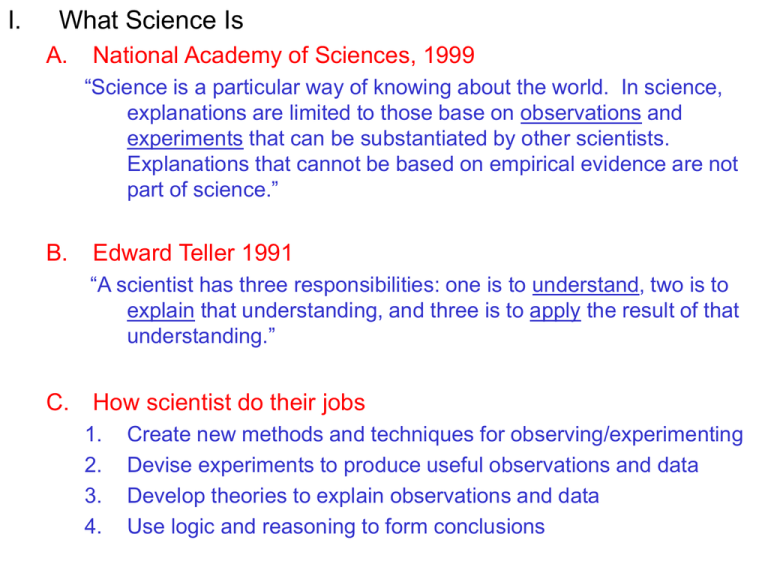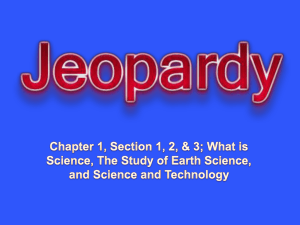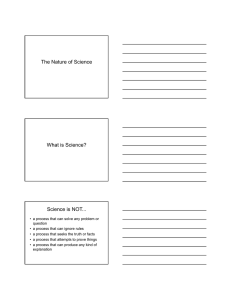I. What Science Is A. National Academy of Sciences, 1999
advertisement

I. What Science Is A. National Academy of Sciences, 1999 “Science is a particular way of knowing about the world. In science, explanations are limited to those base on observations and experiments that can be substantiated by other scientists. Explanations that cannot be based on empirical evidence are not part of science.” B. Edward Teller 1991 “A scientist has three responsibilities: one is to understand, two is to explain that understanding, and three is to apply the result of that understanding.” C. How scientist do their jobs 1. 2. 3. 4. Create new methods and techniques for observing/experimenting Devise experiments to produce useful observations and data Develop theories to explain observations and data Use logic and reasoning to form conclusions D. How scientists share their results 1. Multimedia presentations at professional meetings 2. Carefully written papers in peer-reviewed journals a. Originality of the research b. Quality of the methods and of the data presented c. Reasonableness of the conclusions presented 3. Published science is always open to modification or falsification a. b. c. d. Art/Theatre/Literature are personal expressions with no “right” answer Religion requires a personal faith and is not falsifiable Science can always be falsified and a better explanation proposed Scientific claims should always be viewed as tentative E. What Science is not 1. 2. 3. 4. 5. Sometimes giving counter-example is helpful in defining a term Astronomy vs. Astrology Psychology vs. Parapsychology Cosmology vs. Mythology Sometimes this is not so simple: Superstring Theory F. How Science is Applied 1. 2. Engineers and Technologists apply science to specific problems Many useful products are applications of science a. b. c. 3. Computers Pharmaceutical Drugs Communication devices: cell phones, satellites, etc… Some applications of science have dubious benefits a. b. c. Weapons of Mass Destruction Illegal Drugs Greenhouse gases and Ozone depleting gases G. Science and Culture 1. 2. 3. 4. Western Culture and Modern Science are Compatible Other cultures value science/technology in different ways Chinese medicine has shown value in healing unaccounted for by modern science Western lifestyle made possible by science may not be perceived as superior by all other cultures II. Science for All Americans (AAAS, 1990) A. The Scientific World View 1. 2. 3. 4. B. Scientific Inquiry 1. 2. 3. 4. 5. C. The world is understandable Scientific ideas are subject to change Scientific knowledge is durable Science cannot provide complete answers to all questions Science demands evidence Science is a blend of logic and imagination Science explains and predicts Scientists try to identify and avoid bias Science is not authoritarian The Scientific Enterprise 1. 2. 3. 4. Science is a complex social activity Science is organized into content disciplines and is conducted in various institutions There are generally accepted ethical principles in the conduct of science Scientists participate in public affairs both as specialists and citizens III. Themes of Science A. Science as a Way of Thinking 1. Beliefs a. b. 2. Curiosity a. b. c. d. 3. Science is ideally based only on evidence and is tentative Scientists are human, however, and begin to “believe” their theories Scientist tend to explore and ask questions about almost anything Examples: Leonardo da Vinci, Benjamin Franklin They are motivated to “find the truth” This curiosity can lead them to risk ridicule or controversy to find out Imagination a. b. c. d. Great leaps in science often come because of a imaginative scientist Kekule’s dream about the structure of benzene Thomson’s “Plum Pudding” analogy for the structure of atoms Einstein: “imagination is more important than knowledge” 4. Reasoning a. Inductive Reasoning: piecing together facts and principles to arrive at new conclusions b. Deductive Reasoning: applying known principles to new situations c. Hypothetical-Deductive approach: state hypothesis, experiment to prove or disprove it 5. Cause and Effect Relationships a. Science experiments try to produce an effect with a controlled cause b. Science tries to explain why, rather than just find out if c. Cause and Effect is often difficult to establish i. If you cut off its oxygen supply, a mouse will die ii. If you smoke, you will get lung cancer 6. Skepticism • • • Science continually examines itself as well as the natural world Scientific principles are always modifiable and falsifiable Quantum Mechanics, for example, has modified Classical Physics 7. Objectivity and Open-Mindedness a. This attitude allows scientists to recognize novel observations b. Scientists are human; they have biases and beliefs too B. Science as a Way of Investigating 1. “The” scientific process—Karl Pearson, 1937 a. b. c. d. e. Observing, Collecting Data, Hypothesizing, Experimenting, Concluding Science instruction often teaches this process as absolute Scientists rarely follow this, or any other, rigid process Each scientist has a unique way of learning about nature Percy Bridgman (1950) “The scientific method, as far as it is a method, is nothing more than doing one’s damndest with one’s mind, no holds barred.” 2. Hypothesis a. A statement of relationships that can be tested: “Increased light intensity will cause increased growth rates of pea plants” b. Difficult to prove a positive statement, but easier to disprove a negative statement: “Increased light will have no effect on the growth rate of pea plants”—Null Hypothesis c. Alternative Hypothesis is the logical conclusion when Null is disproved d. Hypotheses can be revised: “Increased red light intensity…” 3. Observation • • • • • Data and information gathered and organized to make sense of nature Repeated observations lead to “facts” and theories Tycho Brahe’s astronomical observations used by Kepler to theorize about the elliptical orbits of planets The mind can miss observations or manufacture false ones We “see with our minds” not just our eyes 4. Experimentation a. b. c. d. Test ideas and determine cause/effect using controls Greek “science” relied only on reasoning through their ideas Modern science tests ideas with physical experiments Independent Variable (Cause): what is changed by the researcher (light intensity) e. Dependent Variable (Effect): what is observed by the researcher (growth rate) f. Control: holding all other variables constant so that only one variable is causing the change (temperature, humidity, etc…) 5. Mathematics a. b. c. d. Bacon: “Mathematics is the door and the key to science” Math helps us express models to explain our observations Mathematical descriptions of the unobservable atom Galileo’s observation: s = 16t2 for distance a falling object falls D. Science as a Body of Knowledge 1. Facts a. b. c. d. e. f. Directly observable at any time Can be “one-time” events (volcanic eruption) Always contain error: Mass of a proton = 1.008 ± 0.001 amu Science wants to know why the fact is so, not just the fact itself Fact: food poisoning results from eating old or damaged canned foods Context: botulinum bacteria produce toxins that lead to food poisoning 2. Concepts a. Properties in common to a certain set of events of objects b. Elements of a concept: name, definition, attributes, values, examples c. Examples: i. Biology: tree, ape, enzyme ii. Chemistry: reaction, element, isotope iii. Physics: wave, solid, x-ray 3. Principles and Laws a. General descriptions of behavior under a limited set of conditions (How things happen) b. Broader than a concept c. Often accepted as facts; Often described by a mathematical equation d. Example: Chemistry: gas laws describe gas behavior under certain conditions PV = nRT 4. Theories a. Explanations of reality that go beyond the directly observable b. Attempt to explain Why things happen, not just How c. Examples a. Atomic Theory b. Theory of Evolution d. Never become “Fact”; can always be revised or disproved by new data a. Make predictions base on the theory b. If prediction occurs, theory survives to be tested again 5. Models a. Representation of something we can’t observe directly b. Provide physical or mental images for us to examine a. Bohr model of the atom b. Wave model of light c. Teachers need to remind students that models are not reality a. Atoms are not really mini solar systems b. Light is more than a wave (particle, energy, etc…) E. Science, Technology, and Society 1. All three greatly influence each other a. Government Agency NSF (society) provides funds to purchase an NMR spectrometer (technology) to study structure of proteins (science) b. Molecular Biologists (science) use Genetic Engineering (technology) to produce corn immune to disease. The FDA regulates the use of this corn for human consumption (society) 2. Technology a. Technology is the application of science to specific problems b. This often results in useable products for society c. Technology advances when science allows and society demands it i. Cheap home computers ii. Airplane travel across the country 3. Society a. Society (through government) decides what science to fund: biomedical research gets more funding than physical sciences b. Society also decides what technology is desired: cloning, stem cells


